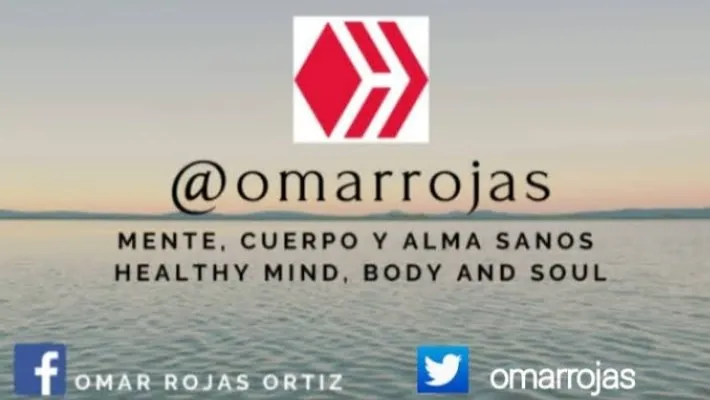Vigorizar los músculos abdominales, tiene el propósito de ofrecerles al cuerpo la resistencia necesaria, para que logre un efectivo rendimiento, por cuanto el abdomen es el sostén del tronco, contribuyen a su movilidad y a mantener una columna vertebral, en óptimas condiciones, en ese orden de ideas, luego de meditar, se proponen una serie de ejercicios de calentamiento corporal y la postura de yoga; Eka Pada Uttanasana o variante de la pinza, con un brazo extendido lateralmente y una pierna estirada hacia atrás, con la finalidad de obtener la importante vigorización de los músculos abdominales.
La mencionada postura Eka Pada Uttanasana o variante de la pinza, se desarrolla estando parados, con el torso y los brazos extendidos hacia delante, luego de apuntar con las manos a la esterilla, extendemos el brazo izquierdo lateralmente y la pierna derecha hacia atrás, dejando el cuerpo equilibrado, apoyado de la mano derecha y del pie izquierdo. Tan distinguida asana, además de permitir la vigorización de los músculos abdominales, contribuye a equilibrar el cuerpo, aporta flexibilidad a los músculos, es muy recomendada para minimizar la irregular curvatura de la columna vertebral y de los hombros caídos, ofreciendo una buena movilidad de la columna, por consiguiente el mejoramiento de la postura, relaja la tensión lumbar, cervical y de la espalda, es efectiva para la fluidez sanguínea al cerebro, alivia el estrés y calma el sistema nervioso. Amigos, la postura descrita, es muy desafiante, sabemos que requiere mucha práctica, no obstante por sus saludables beneficios, es muy importante su consecuente desarrollo. Éxitos.
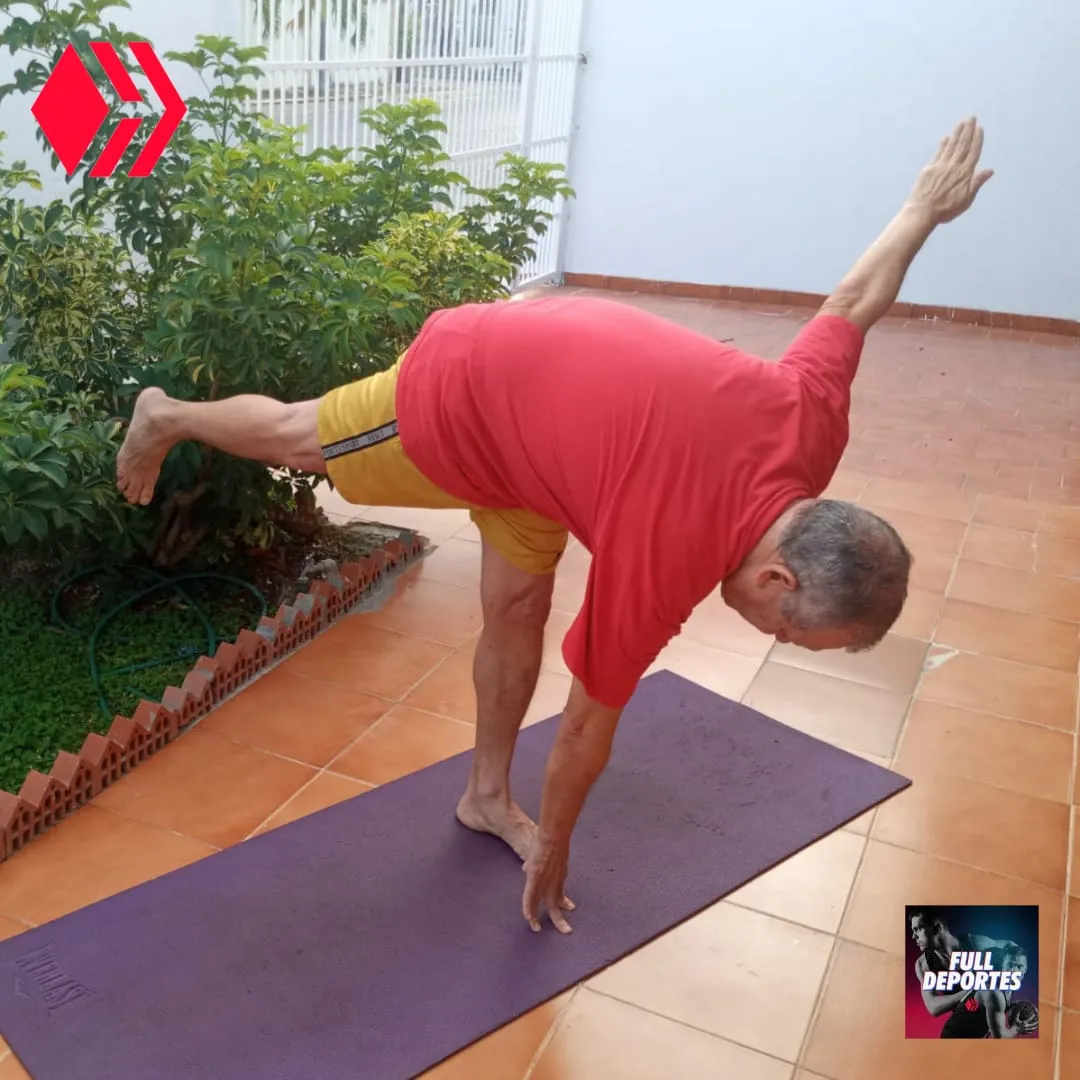
Invigorating the abdominal muscles, has the purpose of offering the body the necessary resistance, so that it achieves an effective performance, since the abdomen is the support of the trunk, they contribute to its mobility and to maintain a spine, in optimal conditions, in that order ideas, after meditating, a series of body warming exercises and yoga posture are proposed; Eka Pada Uttanasana or variant of the pincer, with an arm extended laterally and a leg stretched back, in order to obtain the important invigoration of the abdominal muscles.
The aforementioned Eka Pada Uttanasana posture or variant of the pincer, is developed while standing, with the torso and arms extended forward, after pointing the hands at the mat, we extend the left arm laterally and the right leg backwards, leaving balanced body, supported by the right hand and left foot. This distinguished asana, in addition to allowing the invigoration of the abdominal muscles, contributes to balance the body, provides flexibility to the muscles, is highly recommended to minimize the irregular curvature of the spine and slumped shoulders, offering good mobility of the spine, thus improving posture, relaxes lumbar, cervical and back tension, is effective for blood flow to the brain, relieves stress and calms the nervous system. Friends, the posture described is very challenging, we know that it requires a lot of practice, however, due to its healthy benefits, its consistent development is very important. Successes.
Proceso de Meditación
Meditaremos para relajar el cuerpo y calmar la mente, dicho proceso lo realizaremos, ubicados en la posición arrodillados, con la espalda derecha, las piernas flexionadas delante del torso, juntando las plantas de los pies, doblamos los codos, para colocar las manos en señal de oración, manteniendo el cuello estirado y el rostro alzado, para reflexionar e interanalizar el siguiente escrito: "Si nuestra situación actual no es la mejor, recordemos que muchos en peores situaciones, han salido adelante y son exitosos, no hay excusas, continuemos luchando por un futuro promisor". Éxitos.
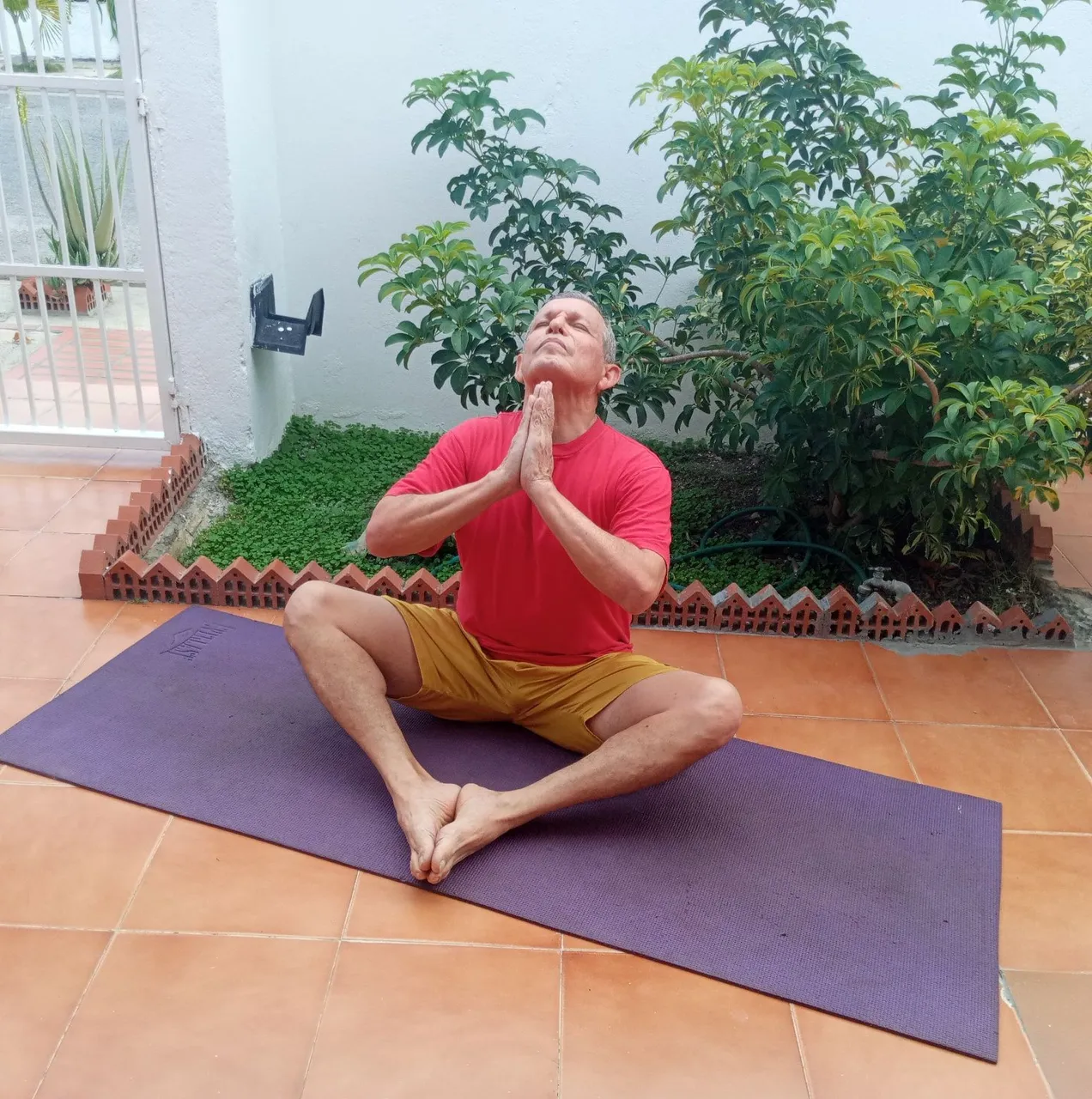
Meditation Process
We will meditate to relax the body and calm the mind, we will carry out this process, located in the kneeling position, with the back straight, the legs bent in front of the torso, joining the soles of the feet, bend the elbows, to place the hands in a sign of prayer, keeping the neck stretched and the face raised, to reflect and interanalyze the following writing: "If our current situation is not the best, let us remember that many in worse situations have come forward and are successful, there are no excuses, let us continue fighting for a promising future". Successes.
Propuesta de ejercicios para calentar el cuerpo e iniciar a vigorizar los músculos abdominales
Este proceso lo realizaremos con el objeto de alcanzar un buen rendimiento, evitar lesiones, flexibilizar los músculos y articulaciones, mediante ejercicios relajantes, muy adecuados para ayudar a vigorizar y fortalecer el abdomen, al igual que los músculos de la espalda, los brazos y las piernas, asimismo son efectivos para el equilibrio corporal. Dichas acciones son;
Parados con la espalda recta, las piernas separadas, los brazos con los codos doblados, las palmas de las manos juntas en señal de oración, flexionamos la pierna izquierda, realizamos la inclinación del torso, llevando las manos hacia dicha pierna, seguidamente, en forma suave giramos el tronco lateralmente, direccionando las manos con las palmas juntas a esa posición. Repetimos, el ejercicio al lado derecho, desde la postura inicial. Los citados ejercicios, tendrán una duración de 6 minutos, descansando 10 segundos por cada dos minutos de ellos. Éxitos.
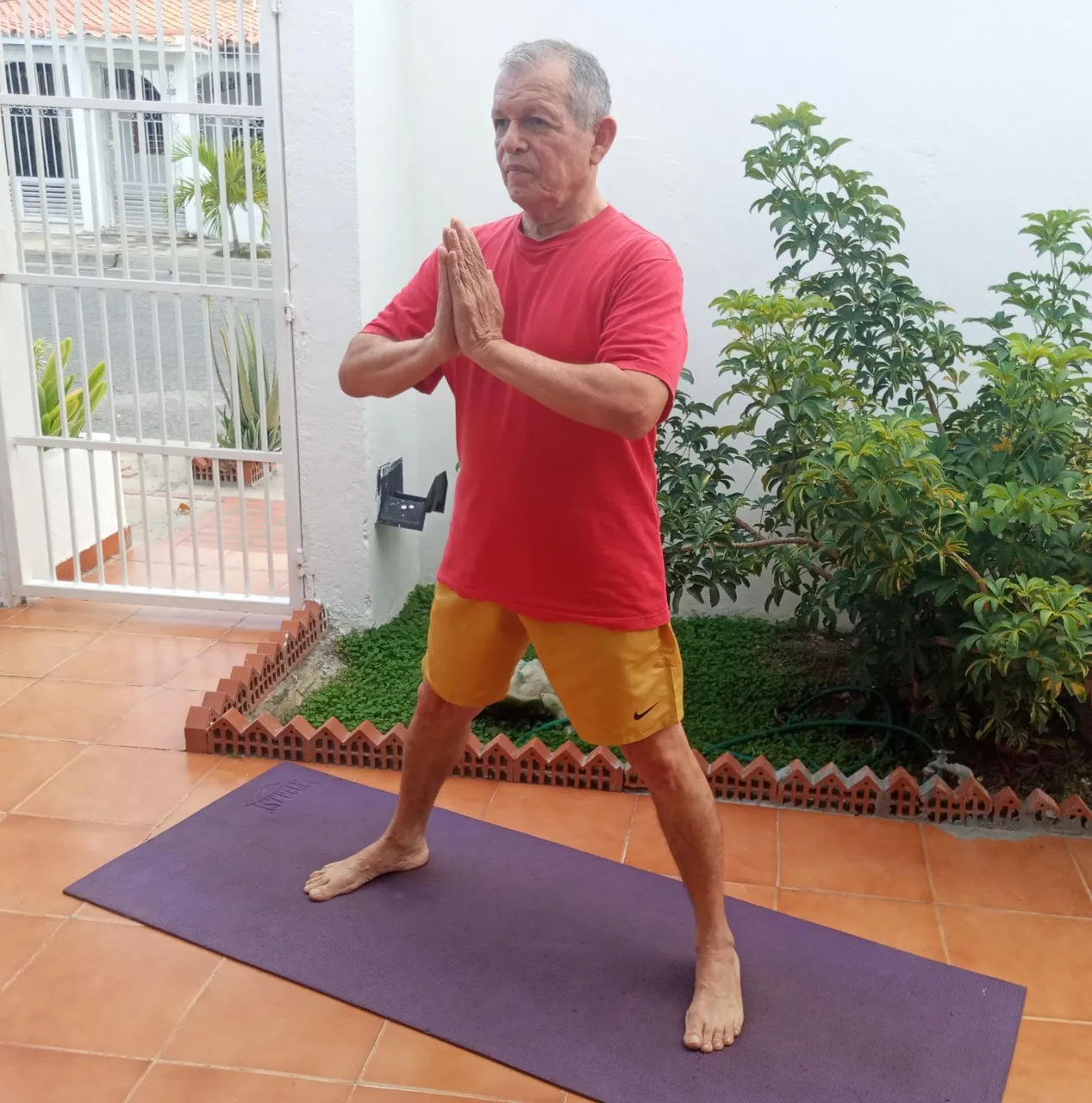
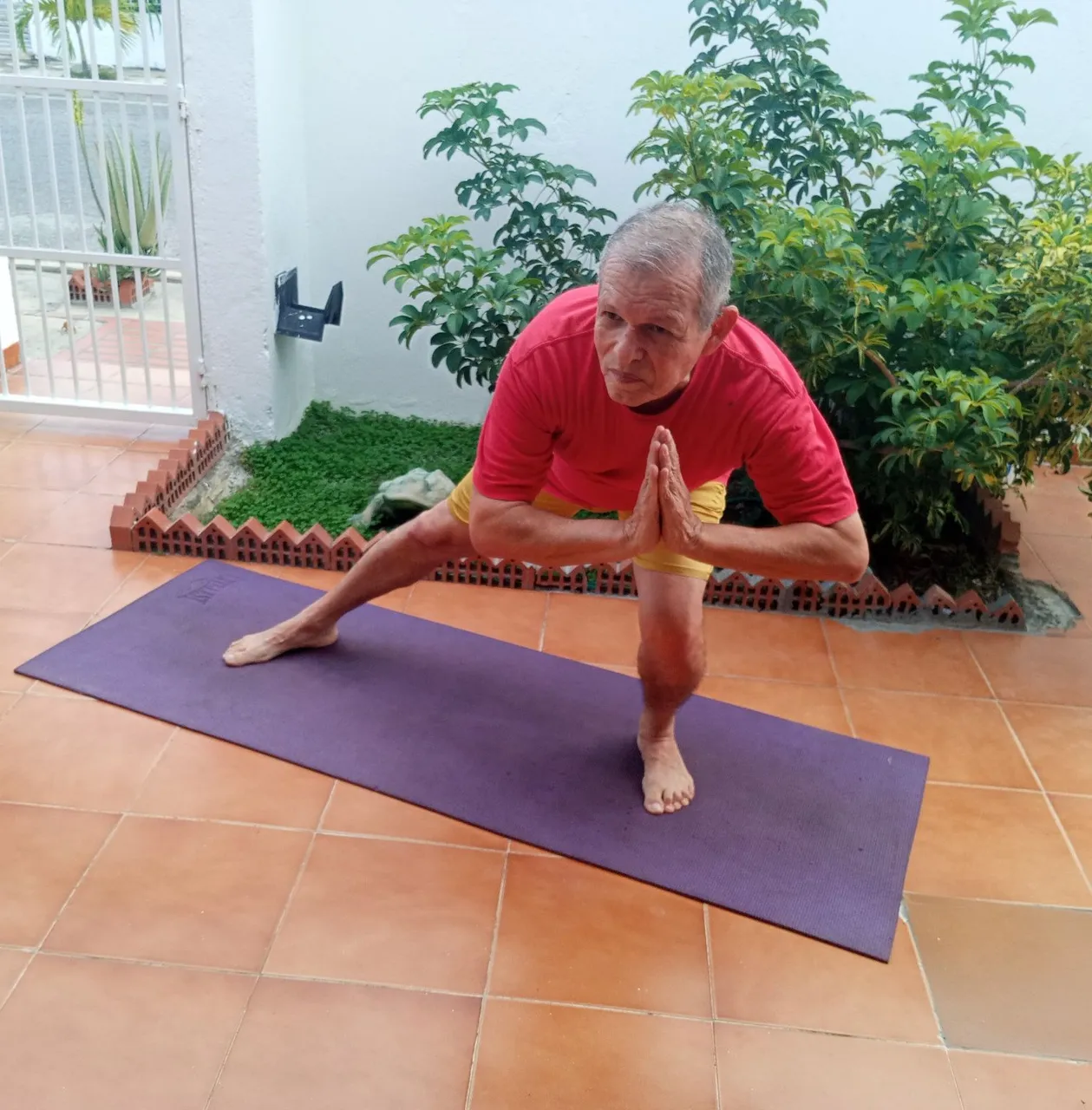
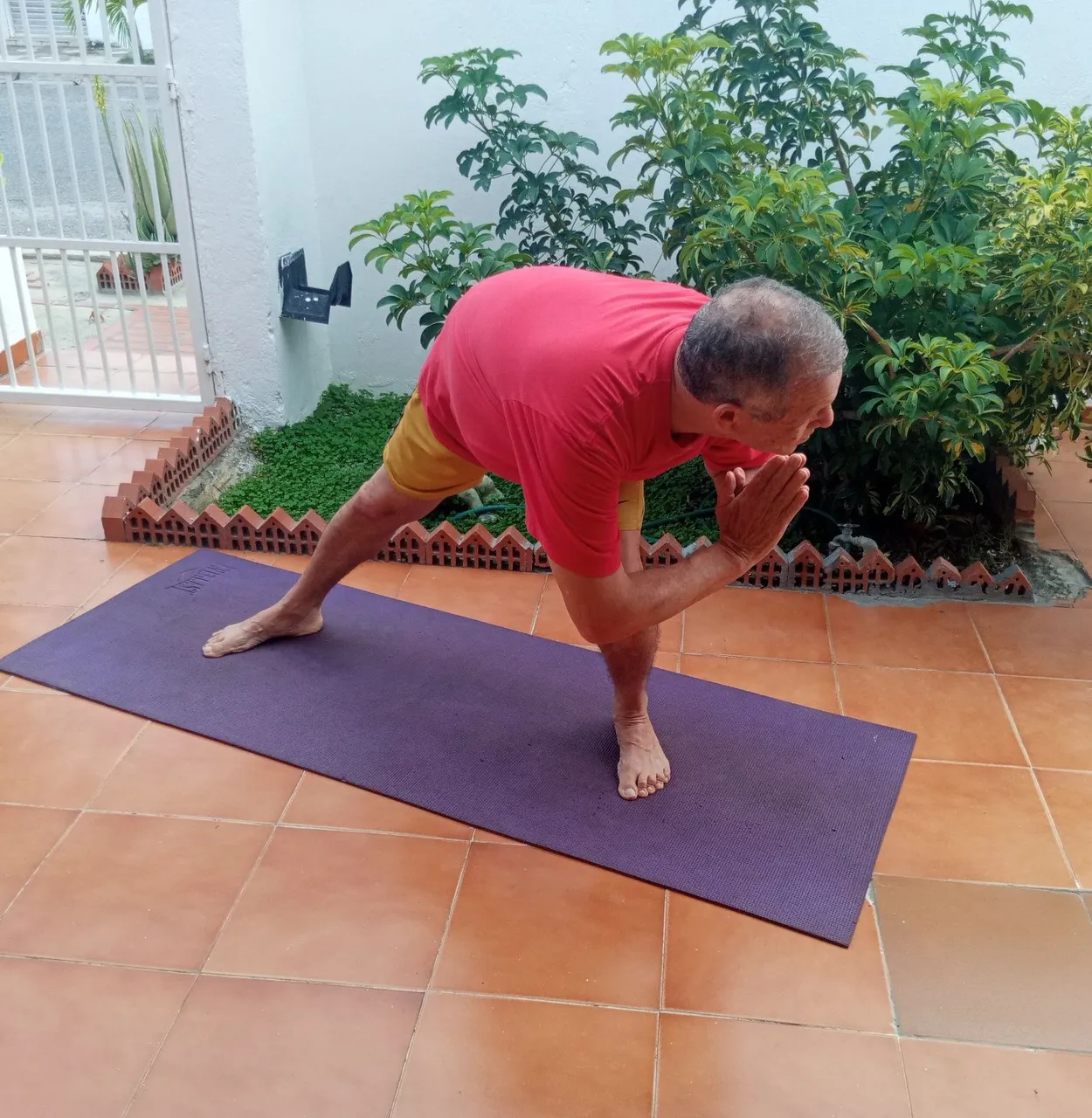
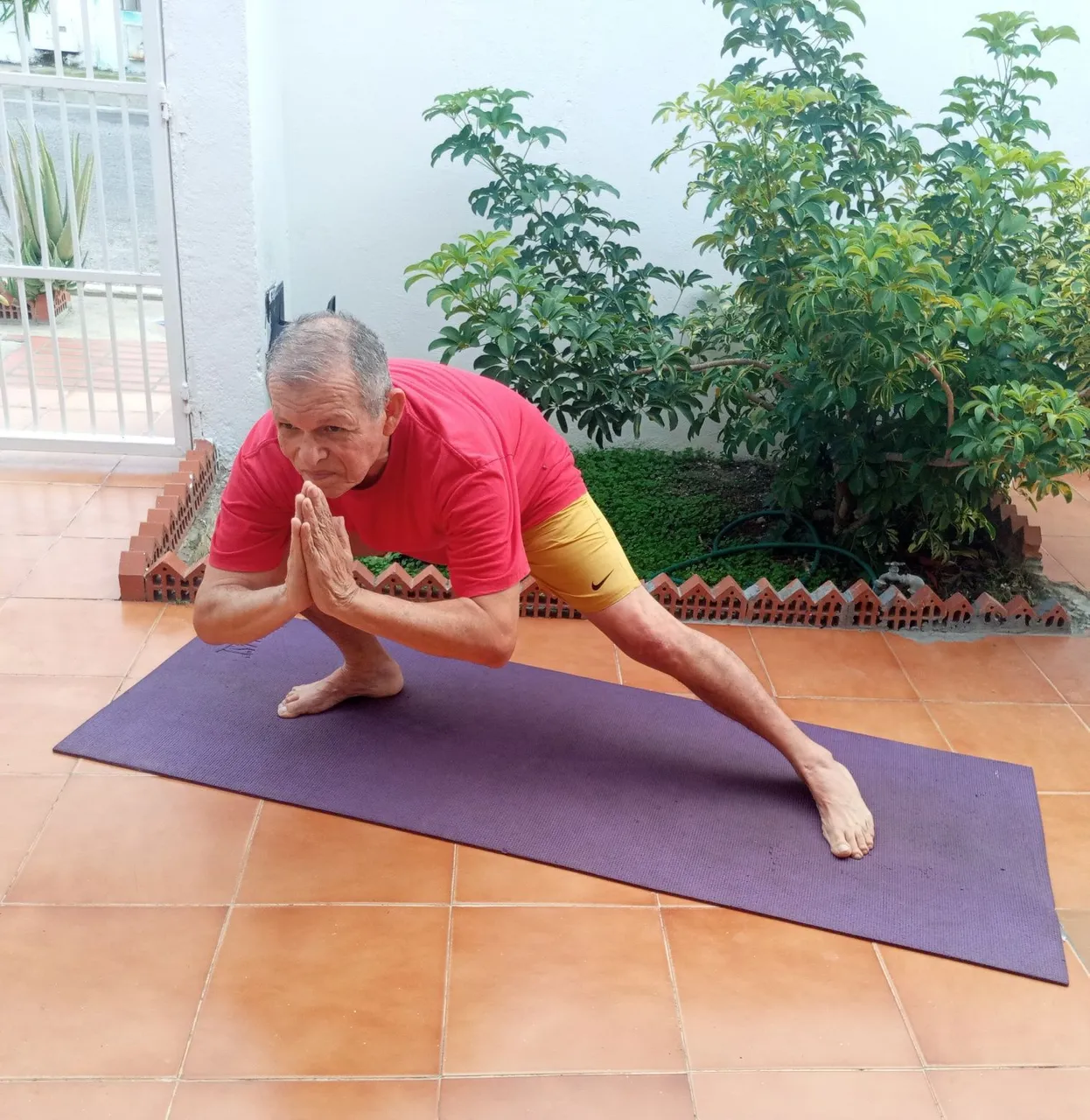
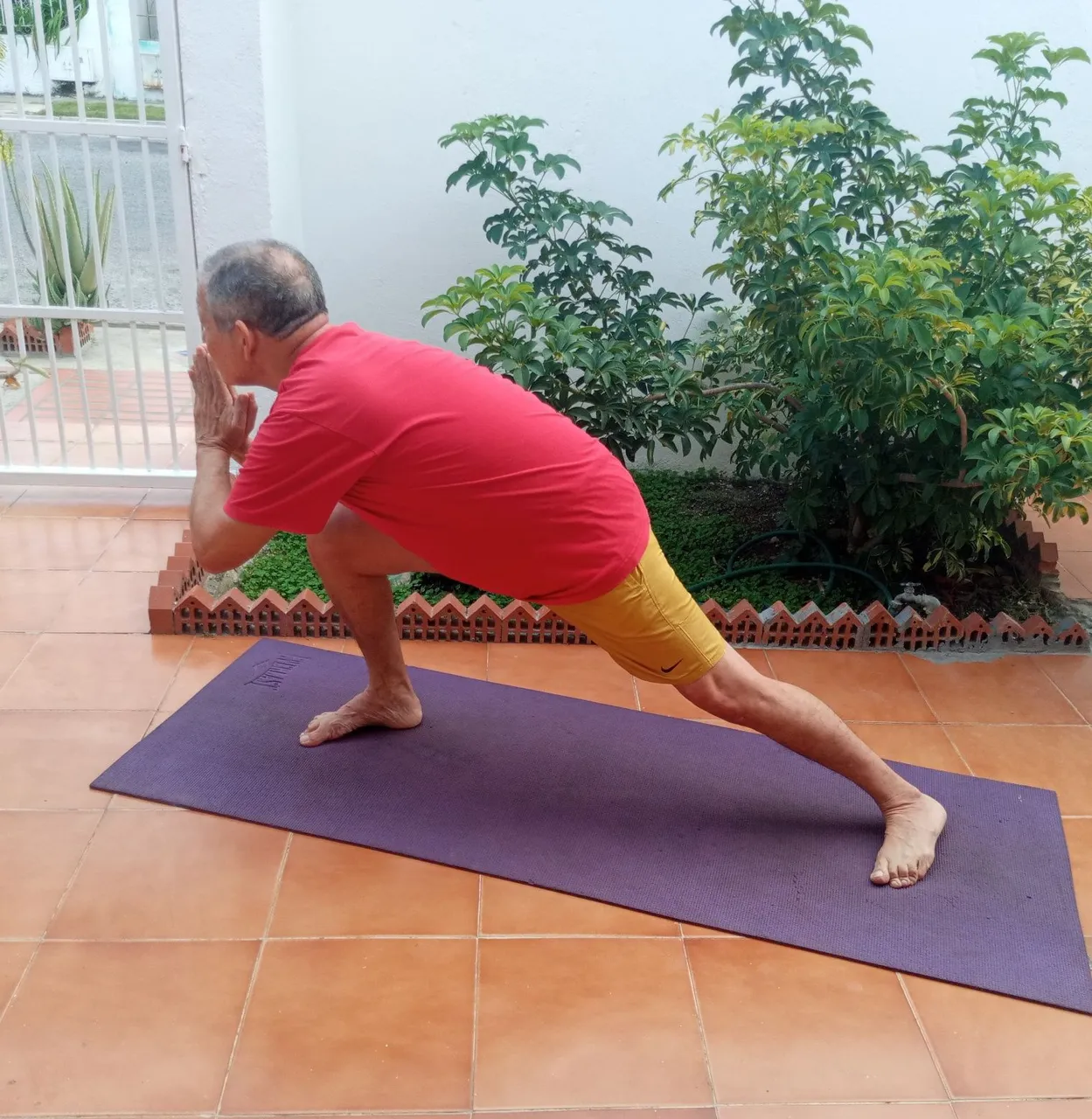
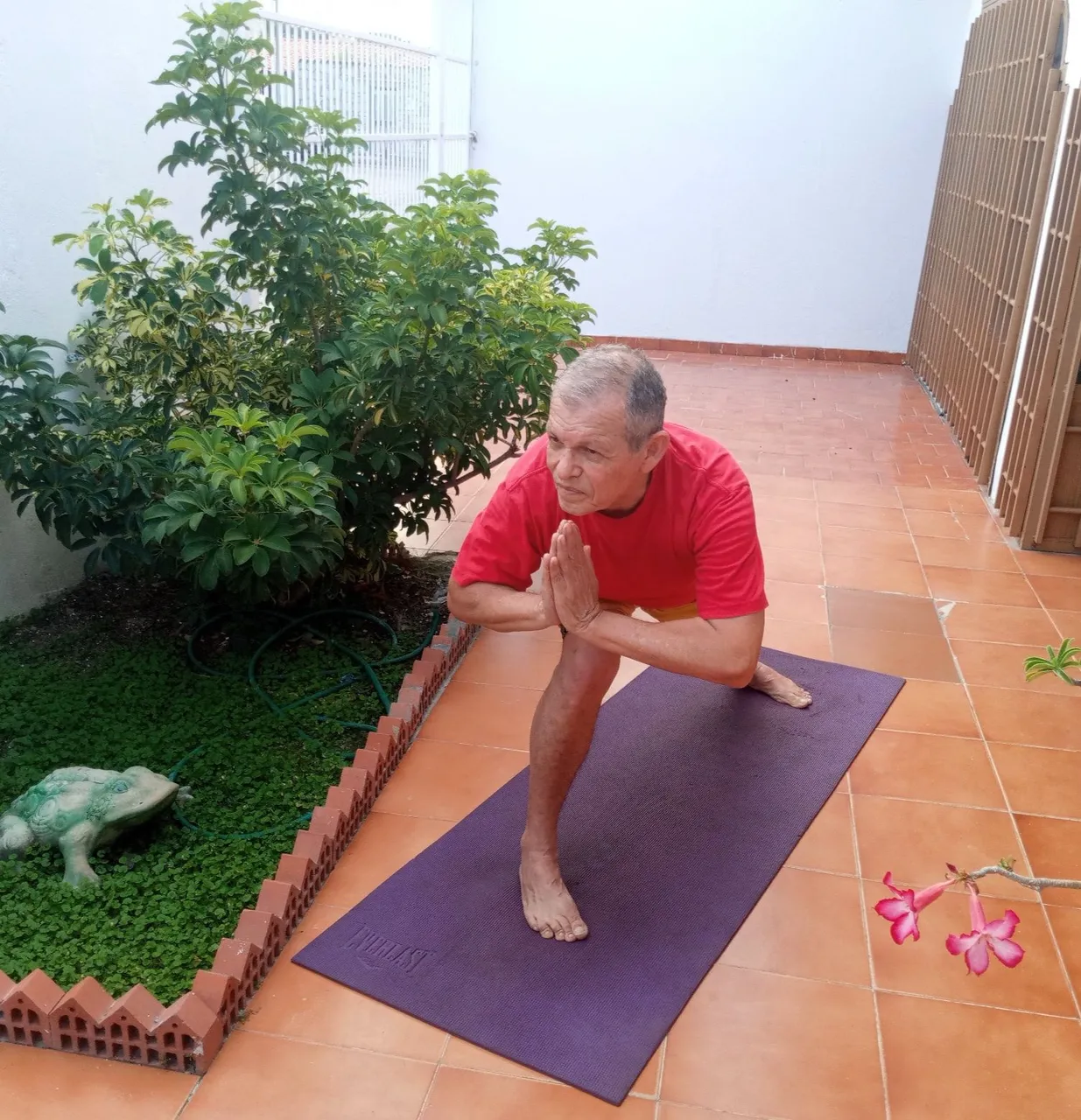
Proposal of exercises to warm up the body and begin to invigorate the abdominal muscles
We will carry out this process in order to achieve good performance, avoid injuries, make muscles and joints more flexible, through relaxing exercises, very suitable to help invigorate and strengthen the abdomen, as well as the muscles of the back, arms and legs. legs, they are also effective for body balance. Said actions are;
Standing with a straight back, legs apart, arms with bent elbows, palms together as a sign of prayer, we flex our left leg, bend our torso, bringing our hands towards said leg, then in the form gently rotate the trunk laterally, directing the hands with the palms together to that position. We repeat the exercise on the right side, from the initial position. The aforementioned exercises will last 6 minutes, resting 10 seconds for every two minutes of them. Successes.
A continuación, estando parados, con la espalda recta, las piernas separadas, entrecruzamos los brazos, de manera que cada mano logre tocar el codo del brazo del lado contrario, flexionamos la pierna izquierda, realizamos la inclinación del torso, llevando los brazos entrecruzados hacia dicha pierna, seguidamente, en forma suave giramos el tronco lateralmente, direccionando los brazos entrecruzados a esa posición. Repetimos, el ejercicio al lado derecho, conforme la postura inicial. Las citadas acciones, tendrán una duración de 6 minutos, descansando 10 segundos por cada dos minutos de ellos. Éxitos.
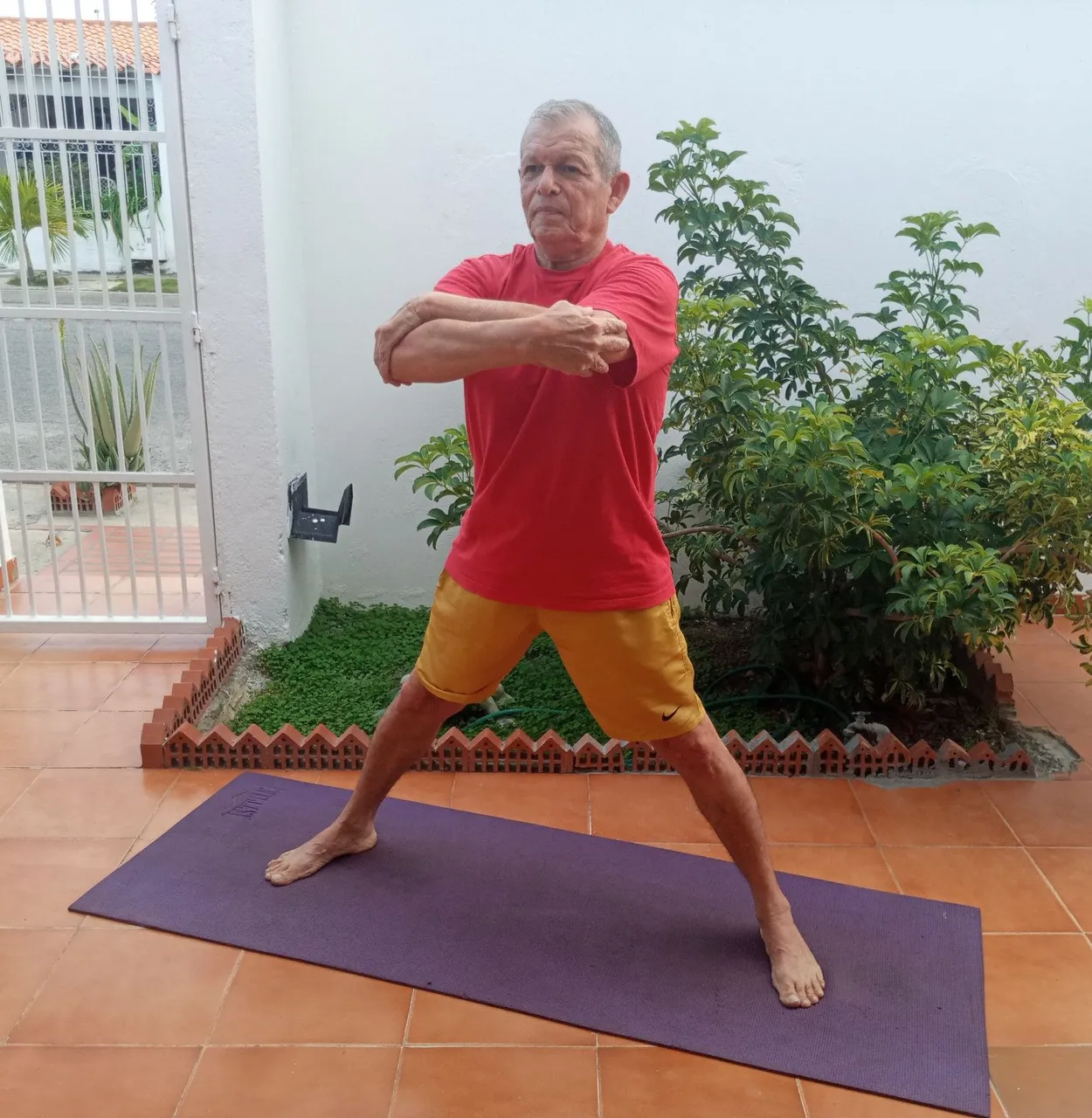
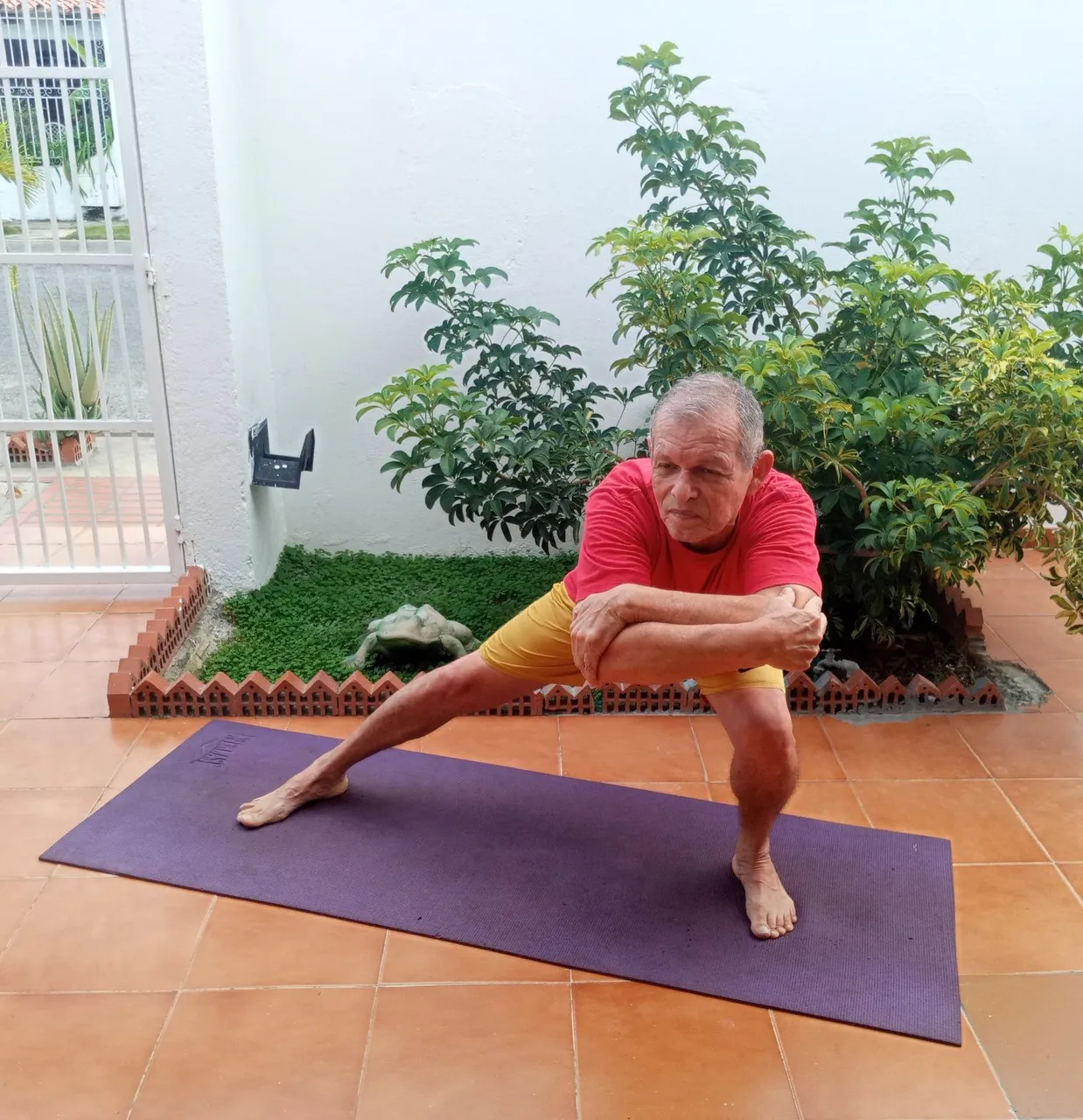
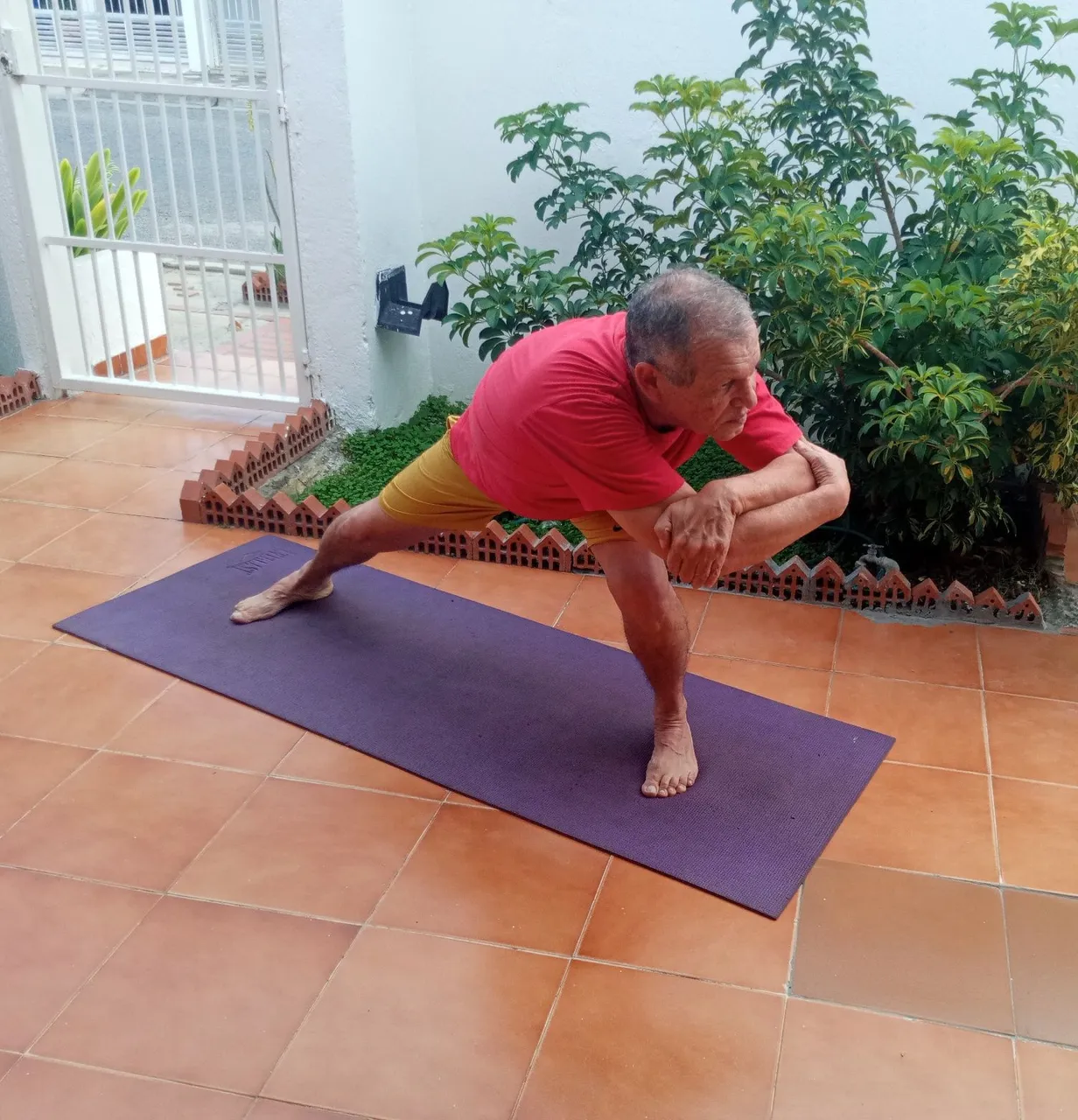
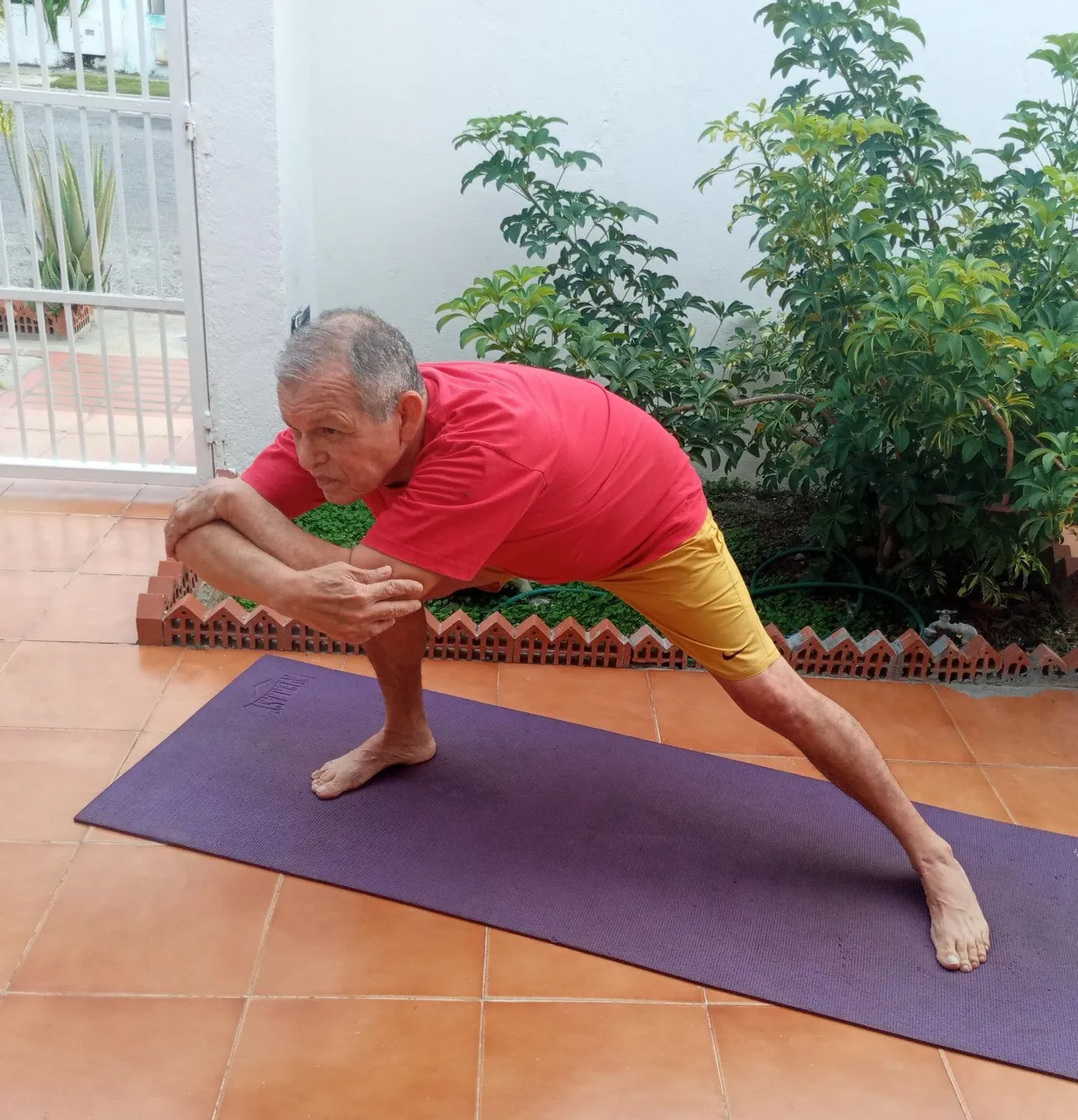
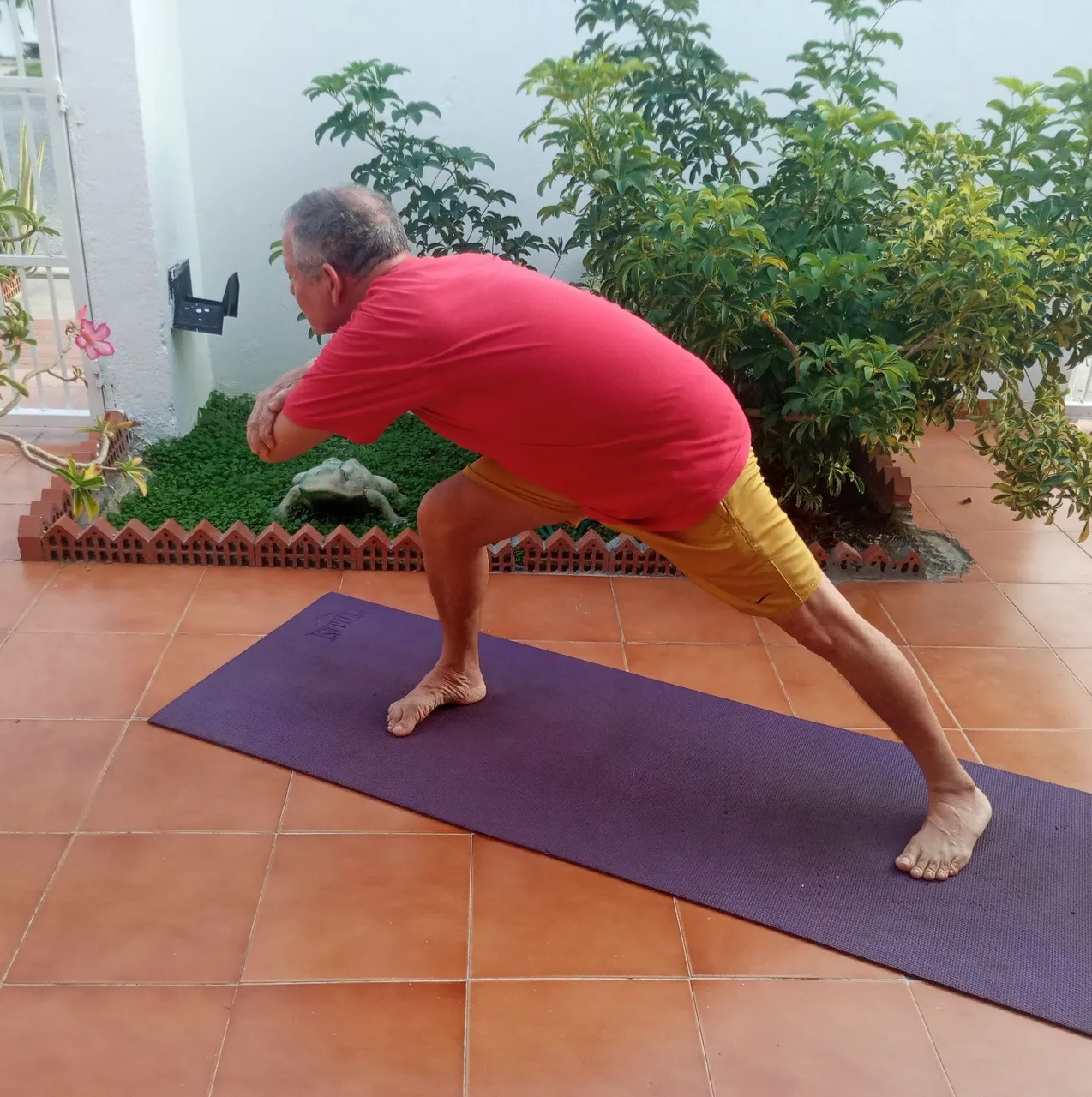
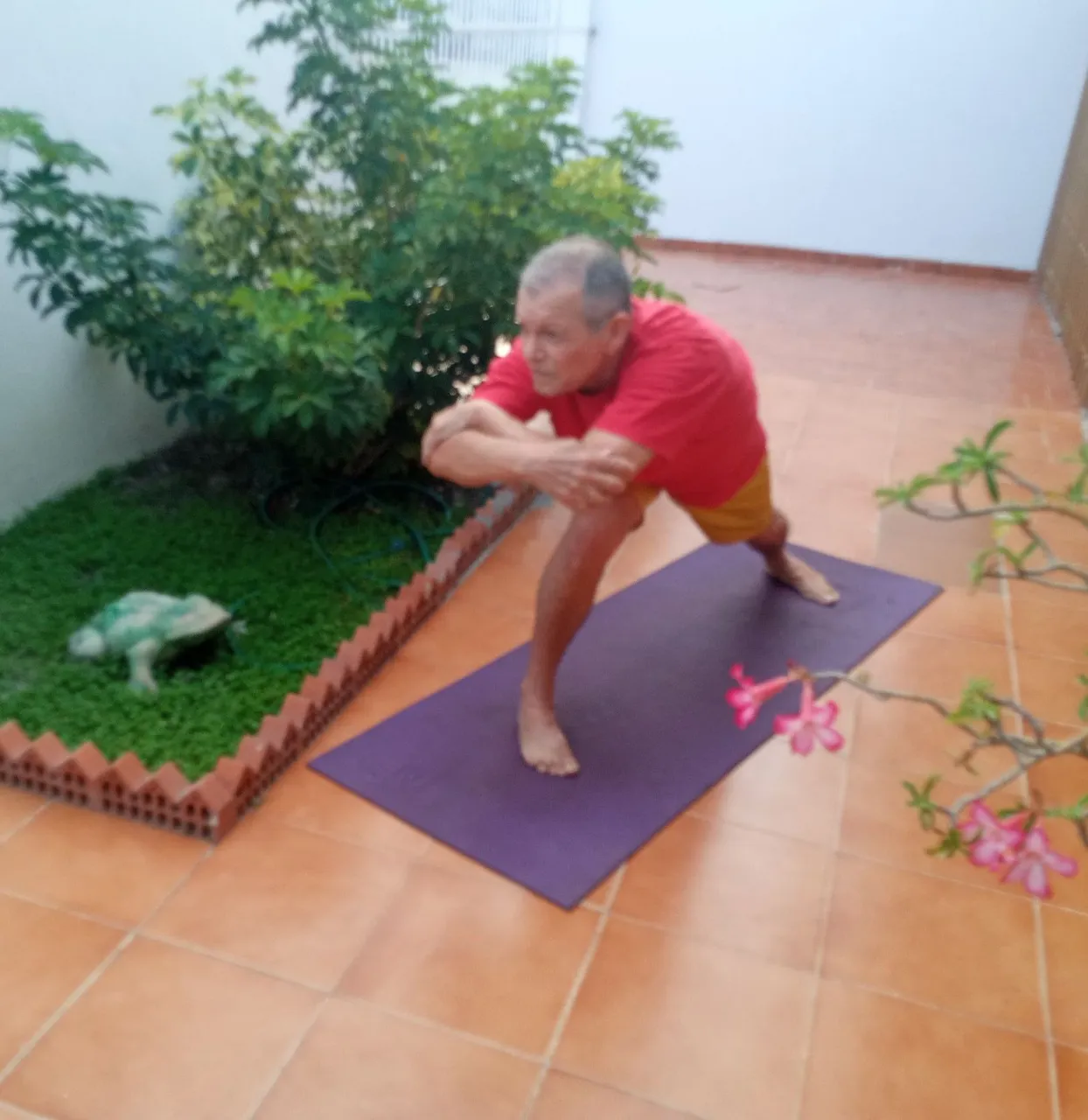
Desarrollo de la postura Eka Pada Uttanasana o variante de la pinza, estando parados, con el torso y los brazos extendidos hacia delante, luego de apuntar con las manos a la esterilla, extendemos el brazo izquierdo lateralmente y la pierna derecha hacia atrás, dejando el cuerpo equilibrado, apoyado del pie izquierdo y la mano derecha
Ubicados en Tadasana o la postura de la montaña; parados con la espalda recta, las piernas juntas, los brazos a los lados del cuerpo, en forma suave flexionamos el torso hacia delante, estiramos los brazos apoyando las manos más abajo de las rodilla, seguídamente conformamos la postura Uttanasana o la pinza, de la siguiente forma, sin tensionar bruscamente el torso, incrementamos suavemente la flexión del mismo, extendemos los brazos, logrando tocar con las manos la esterilla, quedándonos en dicha posición 30 segundos, equilibrados y en resistencia corporal, inspirando aguantando y expulsando aire. Éxitos.
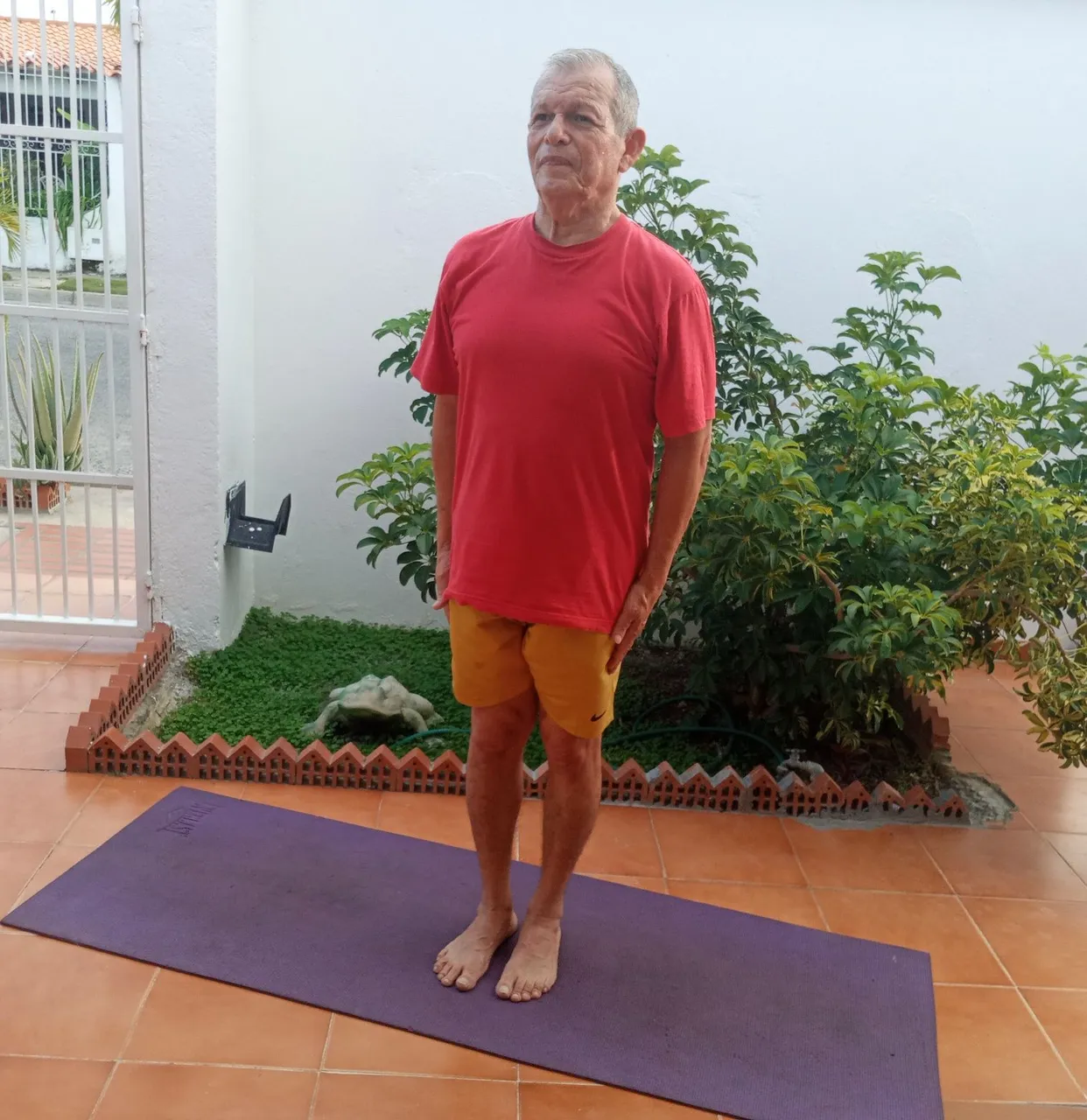
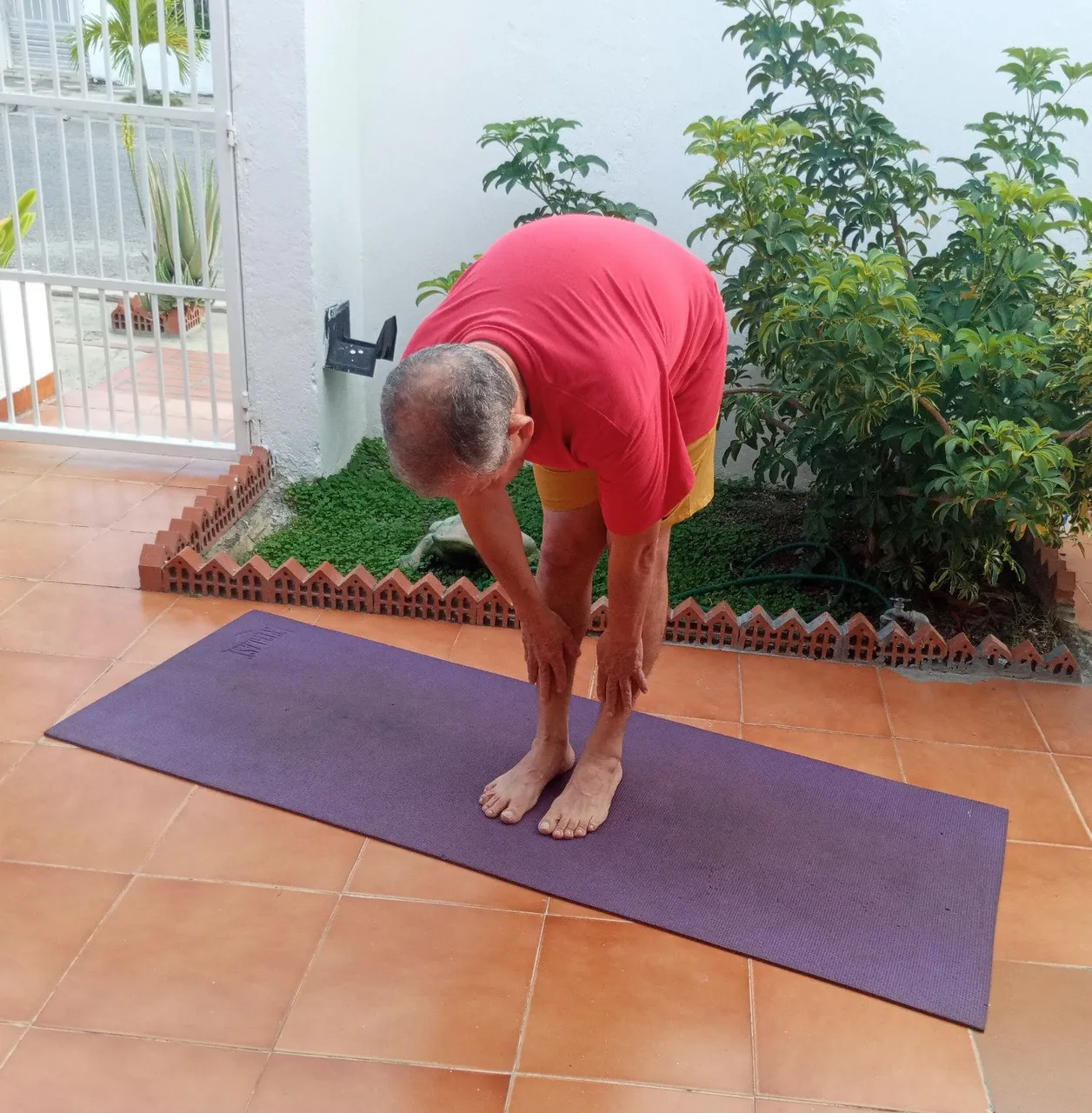
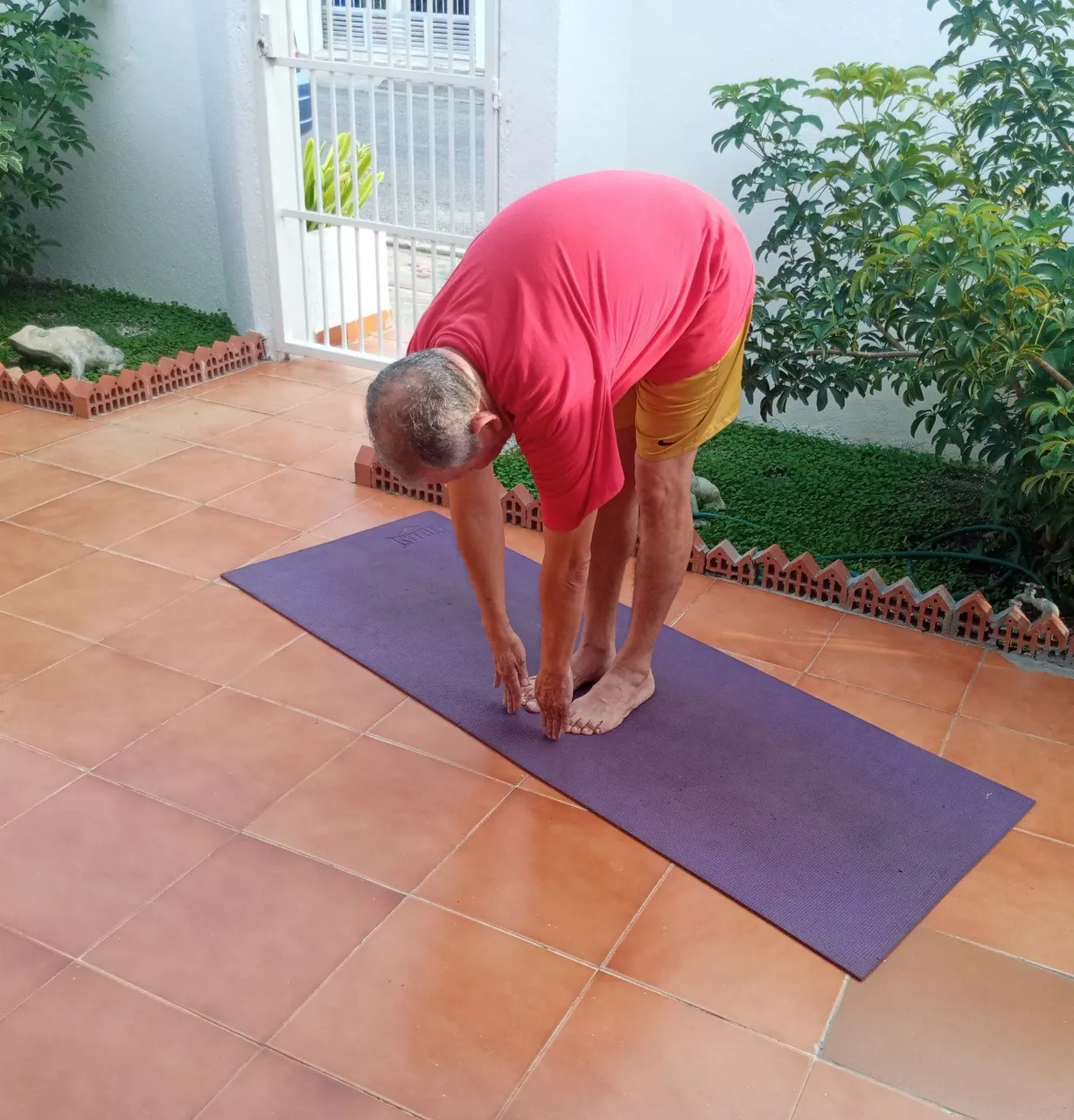
Development of the Eka Pada Uttanasana posture or variant of the clamp, standing still, with the torso and arms extended forward, after pointing the hands at the mat, we extend the left arm laterally and the right leg backwards, leaving the body balanced, supported by the left foot and the right hand
Located in Tadasana or the posture of the mountain; standing with a straight back, legs together, arms by the sides of the body, gently bend the torso forwards, stretch out the arms resting the hands below the knees, then form the Uttanasana or pincer posture, of the following way, without abruptly tensing the torso, we gently increase its flexion, extend our arms, managing to touch the mat with our hands, staying in said position for 30 seconds, balanced and in body resistance, inspiring holding and expelling air. Successes.
Estando en la postura Uttanasana o la pinza, con las piernas bien extendidas, el torso flexionado, los brazos estirados, tocando con las manos la esterilla, logrando mantener el equilibrio, despegamos la mano izquierda de dicha estera, para extender el brazo del citado lado lateralmente, mientras acercamos la mano derecha al pie izquierdo, para seguir equilibrados y en resistencia corporal, inspirando, aguantando y expulsando aire. Éxitos.
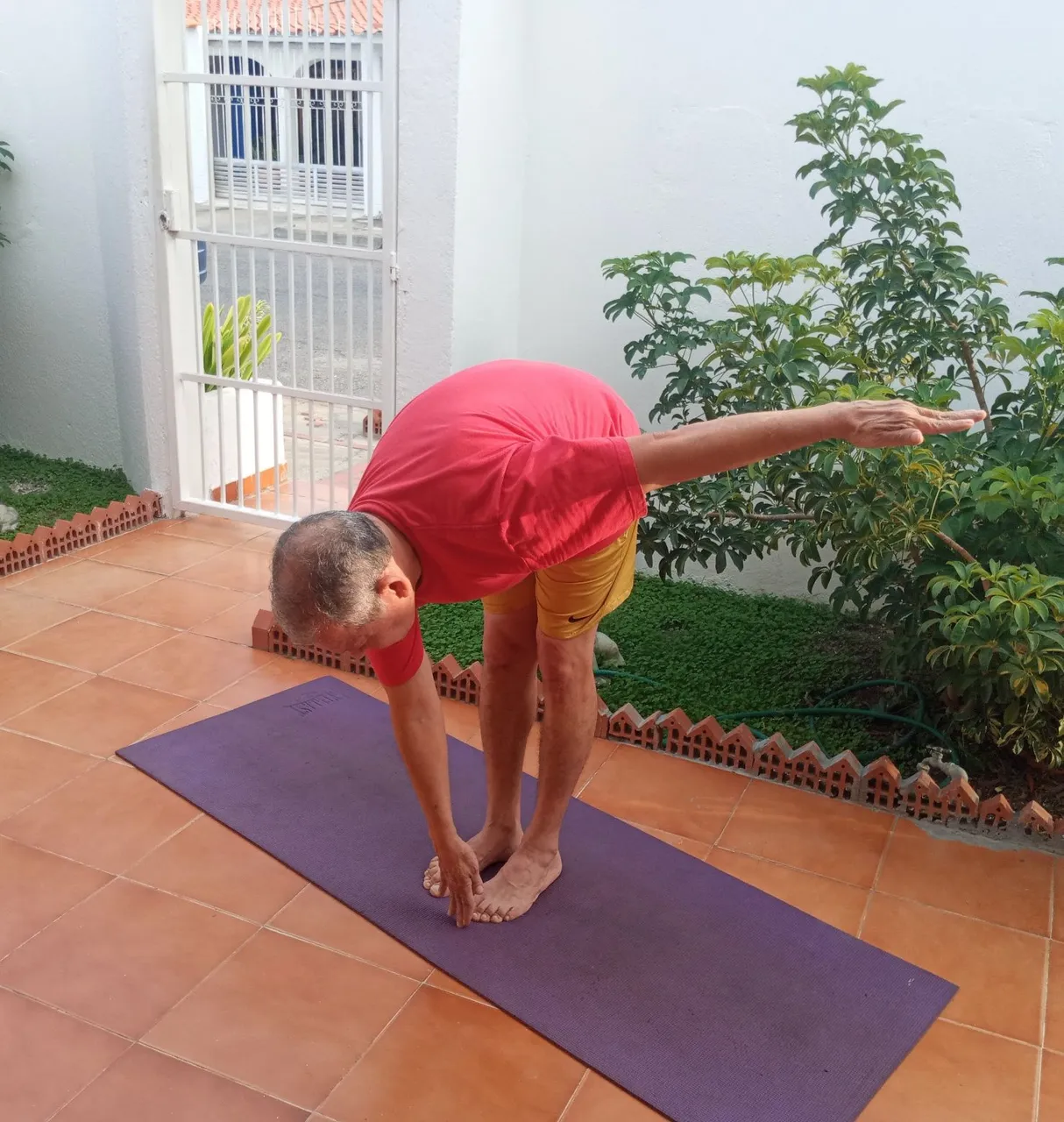
Being in the Uttanasana or pincer posture, with the legs well extended, the torso flexed, the arms stretched out, touching the mat with the hands, managing to maintain balance, we take off the left hand from said mat, to extend the arm on that side laterally, while we bring the right hand closer to the left foot, to continue balanced and in body resistance, inspiring, holding and expelling air. Successes.
Luego de estar posicionado en la postura Uttanasana o la pinza, con las piernas bien extendidas, el torso flexionado, los brazos estirados, tocando con las manos la esterilla, para posteriormente mantenernos en equilibrio, una vez despegada la mano izquierda de la esterilla, cuyo brazo del citado lado está extendido lateralmente, conformamos la postura propuesta Eka Pada Uttanasana o variante de la pinza, procediendo a despegar suavemente, el pie derecho de la estera, para estirar hacia atrás la pierna del mencionado lado, para continuar equilibrados y en resistencia corporal, durando en la asana 30 segundos inspirando, aguantando y expulsando aire. Éxitos.
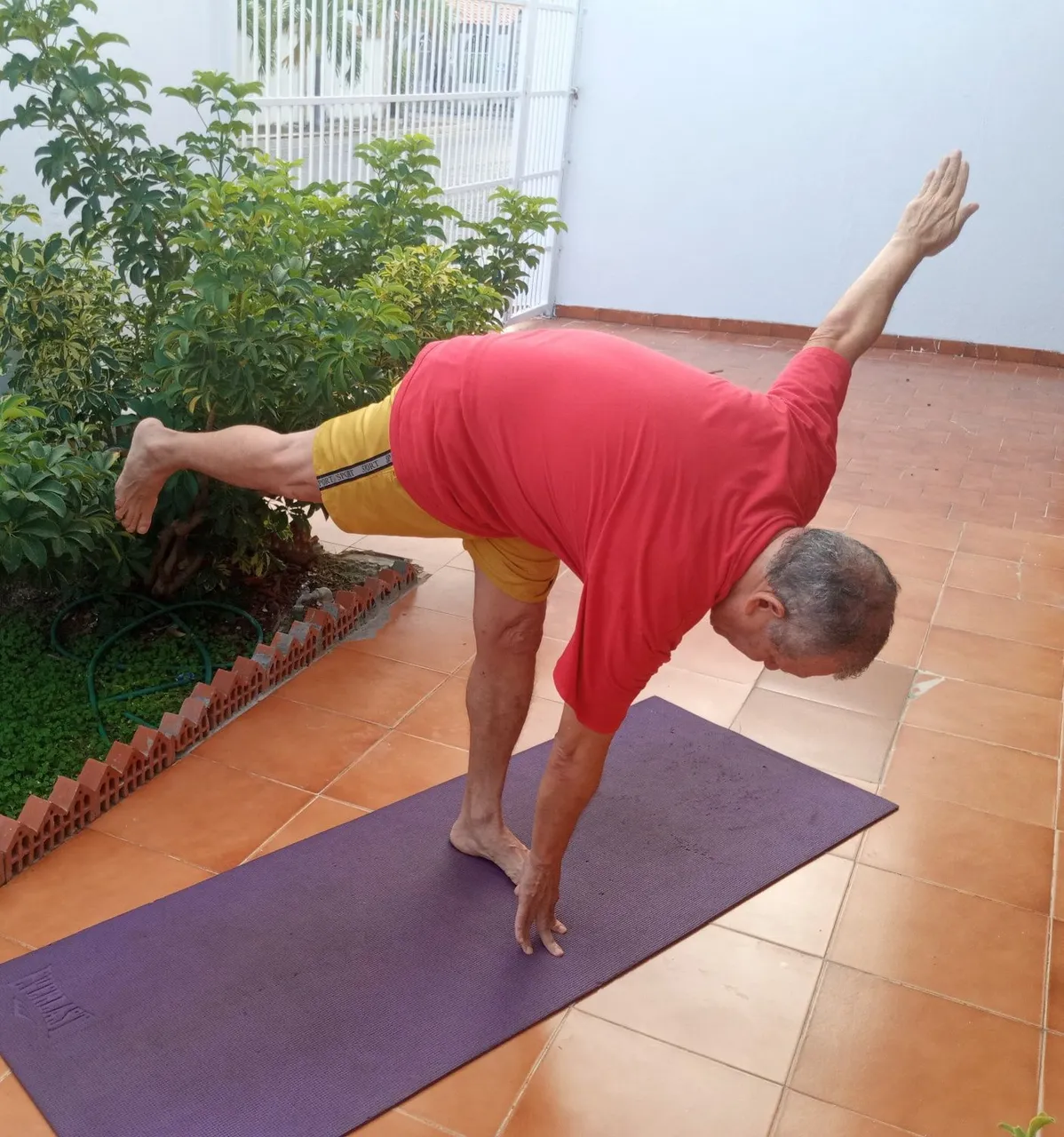
After being positioned in the Uttanasana or pincer posture, with the legs well extended, the torso flexed, the arms stretched out, touching the mat with the hands, to later maintain our balance, once the left hand is detached from the mat, whose arm of the mentioned side is extended laterally, we conform the proposed posture Eka Pada Uttanasana or variant of the clamp, proceeding to gently take off the right foot from the mat, to stretch the leg of the mentioned side backwards, to continue balanced and in body resistance, lasting in the asana 30 seconds inspiring, holding and expelling air. Successes.
Repetimos la asana Eka Pada Uttanasana o variante de la pinza, en esta ocasión de la siguiente manera; desde su inicio, posicionados en la postura Uttanasana o la pinza, con las piernas bien extendidas, el torso flexionado, los brazos estirados, tocando con las manos la esterilla, para posteriormente mantenernos en equilibrio, ahora despegamos la mano derecha de la esterilla, extendemos el brazo derecho lateralmente, procediendo a despegar suavemente, el pie izquierdo de la estera, para estirar hacia atrás la pierna del mencionado lado, equilibrados y en resistencia corporal, duramos en la asana 30 segundos inspirando, aguantando y expulsando aire. Éxitos.
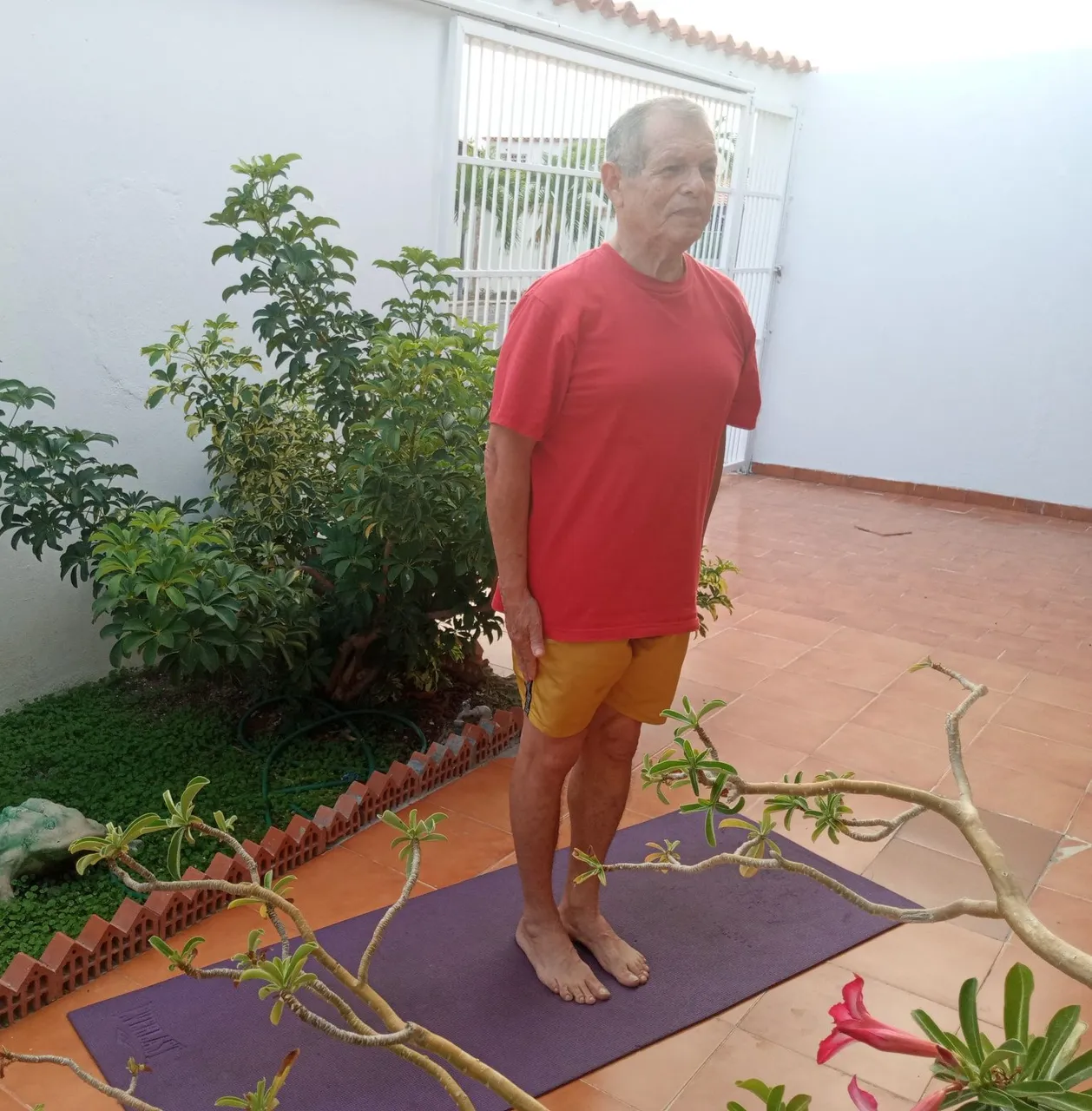
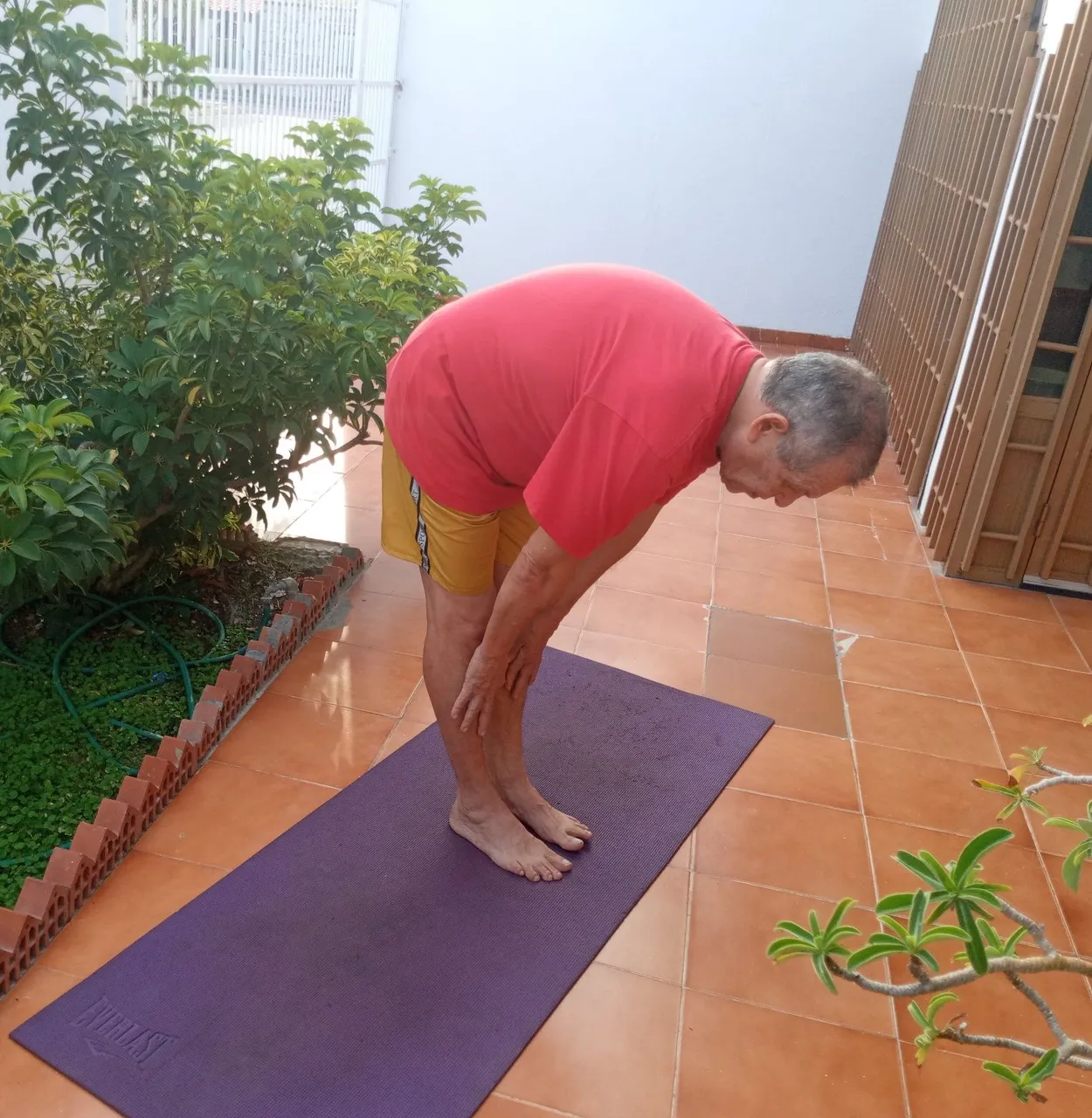
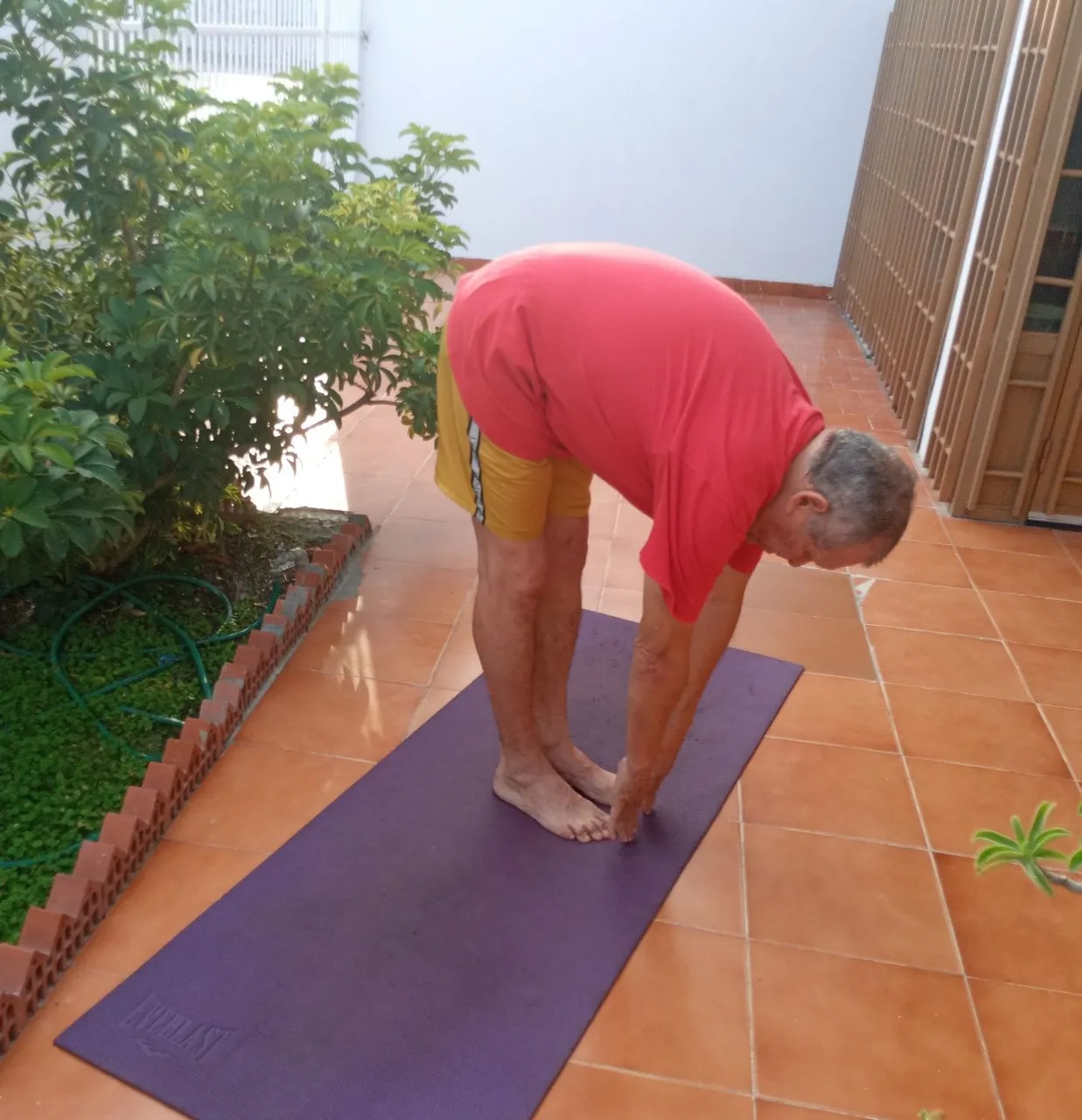
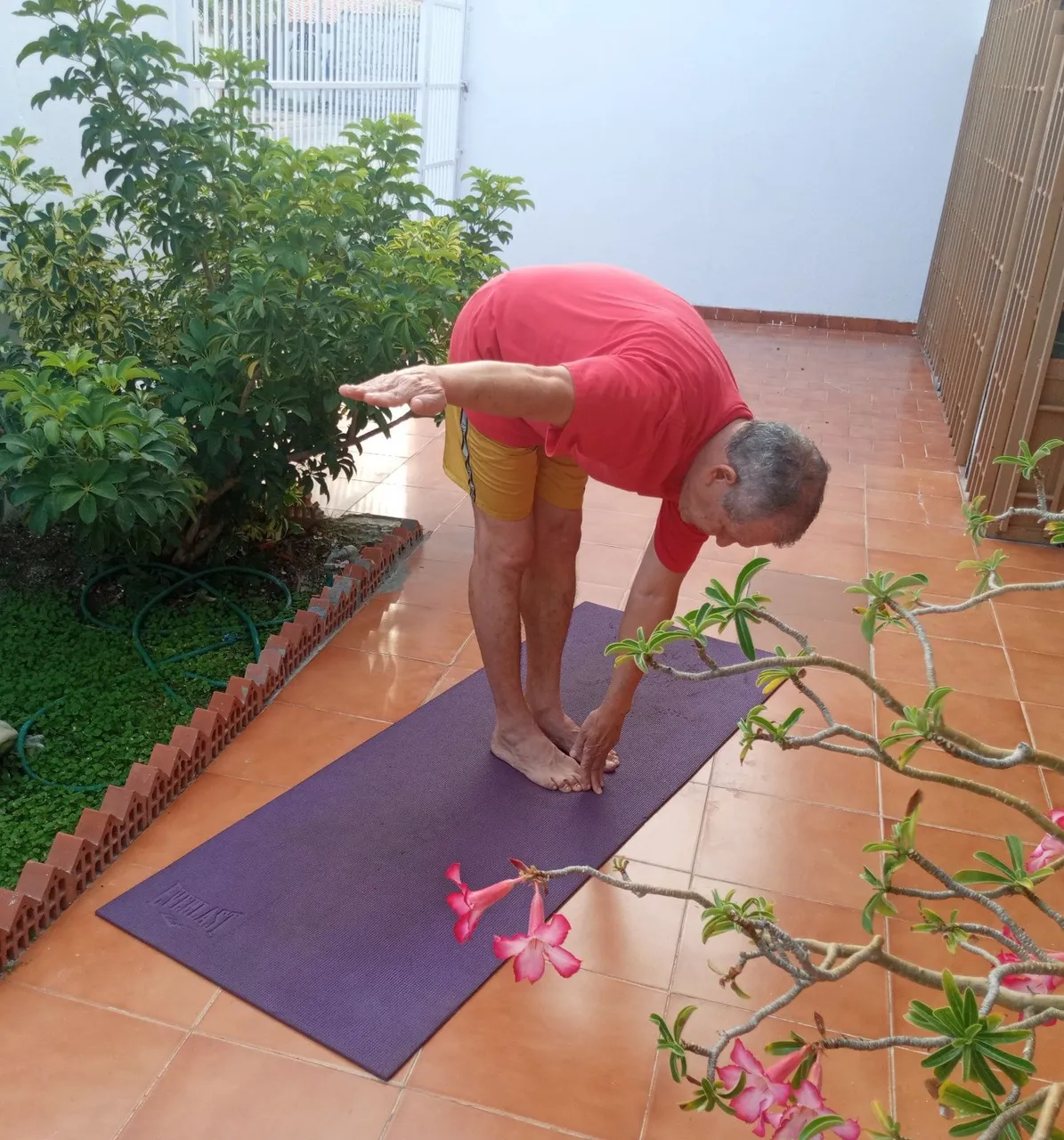
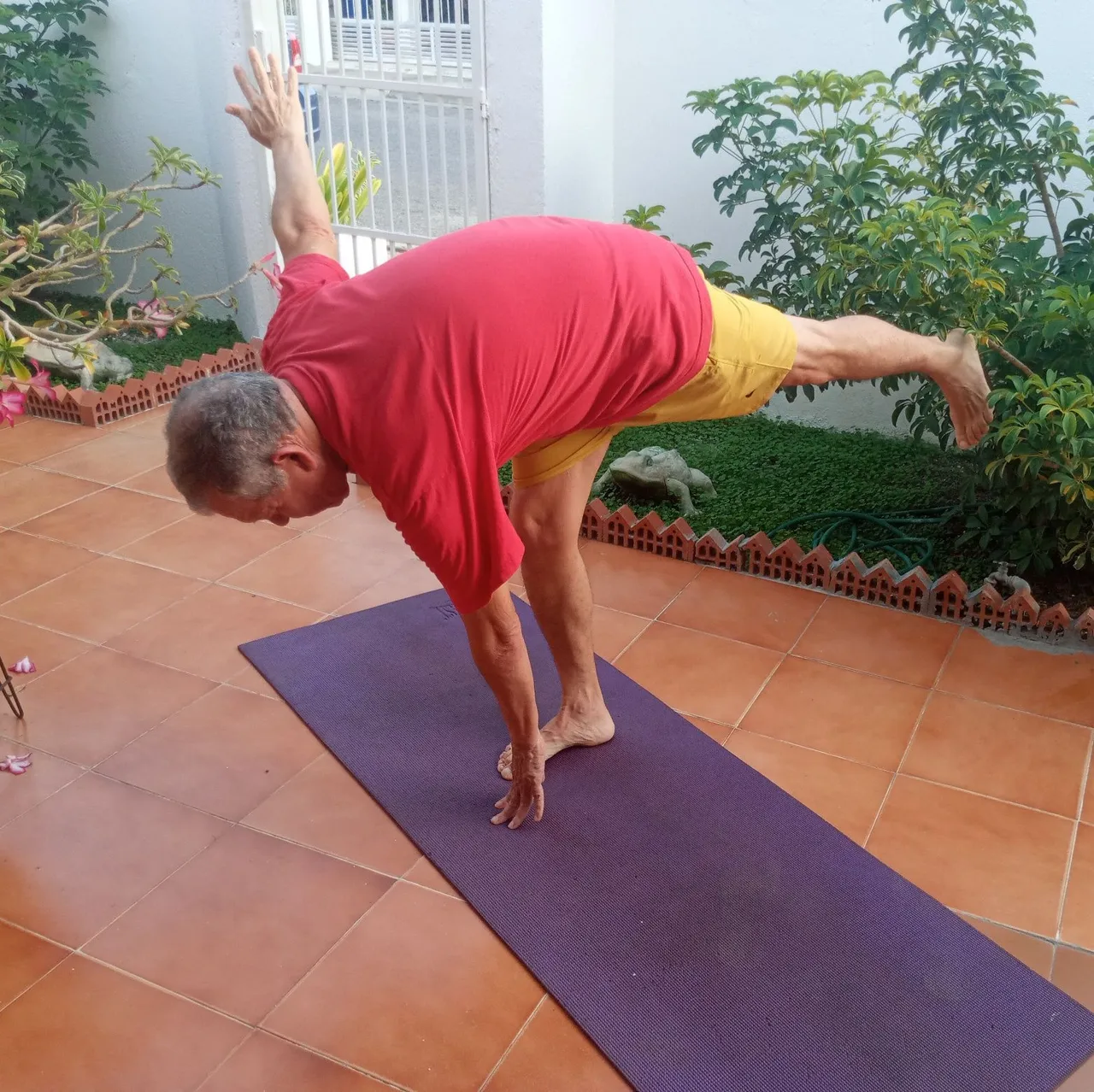
We repeat the asana Eka Pada Uttanasana or variant of the clamp, this time as follows; from the beginning, positioned in the Uttanasana or pincer posture, with the legs well extended, the torso flexed, the arms stretched out, touching the mat with the hands, to later maintain ourselves in balance, now we detach the right hand from the mat, extend the right arm laterally, proceeding to gently take off the left foot from the mat, to stretch the leg on the mentioned side backwards, balanced and with body resistance, we last in the asana for 30 seconds, inspiring, holding and expelling air. Successes.
Beneficios de la postura Eka Pada Uttanasana o variante de la pinza, estando parados, con el torso y los brazos extendidos hacia delante, luego de apuntar con las manos a la esterilla, extendemos el brazo izquierdo lateralmente y la pierna derecha hacia atrás, dejando el cuerpo equilibrado, apoyado del pie izquierdo y la mano derecha
- Es una excelente postura, que permite la vigorización de los músculos abdominales.
- Contribuye a equilibrar el cuerpo.
- Aporta flexibilidad a los músculos.
- Es muy recomendada para minimizar la irregular curvatura de la columna vertebral y de los hombros caídos.
- Favorece una buena movilidad de la columna vertebral.
- Es edecuada para el mejoramiento de la postura.
- Es muy buena para relajar la tensión lumbar, cervical y de la espalda.
- Es efectiva para la normal fluidez sanguínea al cerebro.
- Alivia el estrés y calma el sistema nervioso.
Benefits of the Eka Pada Uttanasana posture or variant of the clamp, while standing, with the torso and arms extended forward, after pointing the hands at the mat, we extend the left arm laterally and the right leg backwards, leaving the body balanced, supported by the left foot and the right hand
- It is an excellent posture, which allows the invigoration of the abdominal muscles.
- Contributes to balance the body.
- Provides flexibility to the muscles.
- It is highly recommended to minimize the irregular curvature of the spine and sloping shoulders.
- Promotes good mobility of the spine.
- It is suitable for improving posture.
- It is very good to relax lumbar, cervical and back tension.
- It is effective for normal blood flow to the brain.
- Relieves stress and calms the nervous system.
La postura Eka Pada Uttanasana o variante de la pinza, estando parados con el torso y los brazos estirados hacia delante, apuntando con las manos a la esterilla, para luego extender el brazo izquierdo lateralmente y la pierna derecha hacia atrás, dejando el cuerpo equilibrado, apoyado del pie izquierdo y la mano derecha, es una asana, cuyo desarrollo permite la vigorización de los músculos abdominales, contribuyendo a equilibrar el cuerpo, aportando una efectiva flexibilidad a los músculos. La variante de la pinza, es muy recomendada para minimizar la irregular curvatura de la columna vertebral y de los hombros caídos, producto del exagerado trabajo de oficina y la ausencia de ejercitación del cuerpo. Su práctica cotidiana favorece la movilidad de la columna vertebral, asimismo, es edecuada para el mejoramiento de la postura, para relajar la tensión lumbar, cervical y de la espalda. También es efectiva para la adecuada fluidez sanguínea al cerebro, aliviar el estrés y calmar el sistema nervioso. En síntesis, la presente asana, los ejercicios de calentamiento corporal y la meditación, son acciones que aportan beneficios para la salud. Amigos, al agradecerles su receptividad y motivadoras visitas, me suscribo a ustedes, con mucho afecto. Omar Gustavo Rojas Ortiz desde la ciudad de Cumaná en el estado Sucre-Venezuela.
The Eka Pada Uttanasana posture or variant of the clamp, standing with the torso and arms stretched out in front, pointing the hands at the mat, to then extend the left arm laterally and the right leg behind, leaving the body balanced, supported by the left foot and the right hand, is an asana, whose development allows the invigoration of the abdominal muscles, helping to balance the body, providing effective flexibility to the muscles. The variant of the clamp is highly recommended to minimize the irregular curvature of the spine and sloping shoulders, a product of exaggerated office work and the lack of exercise of the body. Its daily practice favors the mobility of the spine, likewise, it is suitable for improving posture, to relax lumbar, cervical and back tension. It is also effective for proper blood flow to the brain, relieving stress, and calming the nervous system. In summary, the present asana, the body warming exercises and the meditation are actions that provide health benefits. Friends, in thanking you for your receptiveness and motivating visits, I subscribe to you, with great affection. Omar Gustavo Rojas Ortiz from the city of Cumaná in the state of Sucre-Venezuela.
Las imágenes fueron tomadas por Nancy de Rojas con mi celular Samsung Galaxy A10s y la publicación es de mi autoría.
The images were taken by Nancy de Rojas with my Samsung Galaxy A10s cell phone and the publication is my own.
Portada editada en Canva
Cover edited in Canva
Logos propiedad de @hiveio, @fulldeportes
Logos owned by @hiveio, @fulldeportes
